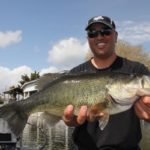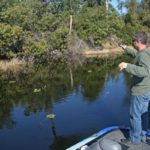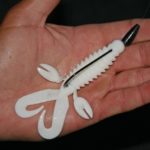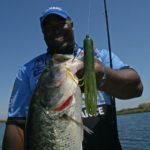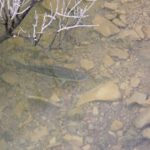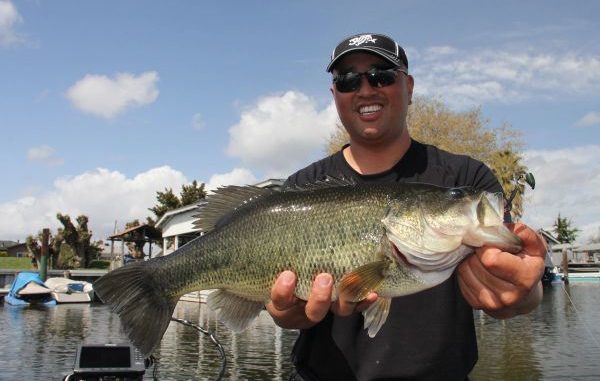
Bass will be up shallow this month for the annual spawn, and that means the big girls are available to catch. But what are the best tactics? These fishing pros tell you everything you need to know.
When bass move shallow to make the next generation can be a time of great opportunity or a time of great frustration.
Seeing a fish does not guarantee a catch, nor does not seeing fish preclude that possibility.
So we asked a handful of Bassmaster Elite Series pros for their insight and advice on how to put more bedding bass in the boat
Here’s what they offered:
Mark Davis
Mark Davis said he water clarity — or more specifically the lack thereof — can present problems for many anglers.
“So many times in the South you don’t have water clarity when you’re talking about spawning fish, so how do you catch a spawning fish that you can’t see?” the Arkansas pro said. “A lot of it comes from experience and being able to distinguish a potential bedding area — I call it ‘beddy.’”
“Sight fishing” is a bit of a misnomer in this situation.
“One thing you want to do is look for any kind of movement, because a lot of time what’s going to happen is when those fish are aggressive on the bed, they’re chasing off bluegill, minnows and other things,” Davis said. “So you’re looking for swirls, any kind of water movement up there shallow around those bedding areas.
“That’s usually the male bass (which indicates a guarded bed).”
Davis also recommended equal doses of patience and persistence. Bolstering these traits with diversity is the key to success.
“You can’t just cast in there one time,” he said. “You have to stay back off the spot; you have to make multiple casts. Those fish that are on the beds aren’t necessarily going to bite the first cast.
“Also, you have to make multiple casts with multiple lures to that little area where you suspect that bed is at.”
Reminding anglers that experienced bass intentionally bed in tucked-away places, David said the approach is important.
“A lot of times, depending on the situation, the easiest cast angle isn’t the one that’s going to get the fish to bite,” he said. “You have to realize that there’s a hotspot in that fish’s bed where he’s going to bite that lure. If you can’t see the bed, you don’t know where that hot spot is. You might be missing it by 6 inches.
“You have to be aware of that, and you may have to change up; you may have to try to get your lure under a limb or over some grass to get your lure into that hotspot.”
For bait selection, Davis opens the bidding with more lure than he realistically expects a fish to bite. This is no frivolity — it’s a calculated strategy intended to jump-start the action.
“It could be a swimbait, a giant crawdad, a big worm, a big lizard — what you’re doing with that is you’re making the fish mad,” Davis said. “Several casts with the big lure, and then you put a little lure like a tube or a jig in there.
“A lot of times, after that big lure’s been in there several times, you put that little lure in there and you catch him.”
Pete Ponds
Hailing from Madison, Miss., Ponds appreciates a diverse array of bait colors, but during the spawn he’s partial to white.
Plain vanilla, boring, no imagination? Nope — good sense.
“When you’re on a really highly pressured lake, I’d recommend using green pumpkin or another natural color, but a lot of times, guys will use white so they can see it,” Ponds said. “When a fish puts that bait in his mouth, that’s when you can set the hook.
“On the Elite Series and in a lot of tournaments, you can’t snag a sight fish. We use white because when it disappears, you know the fish has got it.”
And what about lure size?
“Most of the time, I’ll use a small bait (for the spawn), but sometimes I’ll take a larger bait like a big tube or a big craw and pitch it in there to aggravate that fish,” Ponds said. “After the fish gets (irritated) I’ll pitch a smaller bait in there ,and he instantly consumes it.
“So it’s almost a one-two punch deal.”
Todd Faircloth
The Texas pro said the value of stealthy approaches to bedding fish cannot be overstated.
“Typically, in Louisiana and Mississippi the fish are up shallow and you’re dealing with stained, somewhat muddy water,” Faircloth said. “Even here, your chances of catching a fish are much better if your bait comes to them without them seeing your presence. I like to keep my trolling motor on low speed, keep my distance and be as quiet as possible in the boat.
“I like to use the wind whenever I can for the silent approach and just use my trolling motor to bump me once in a while and keep the nose out.”
Faircloth also uses anything available to hide his presence.
“You can use trees (and other shoreline vegetation) as a buffer or camouflage,” he pointed out. “A lot of times if I’m sight fishing and visually looking for fish, I’ll put something between me and the fish. That kind of buffers your existence with the fish.
“It’s almost like hunting.”
When it comes to his approach, Faircloth said he’ll focus on the sides of cover.
“In the summer and the winter, you’ll fish the heart of the cover, but fish like to spawn on the sides of cover like docks, trees, logs,” he said. “I like to make short pitches to the sides.”
Now, it’s always great when a cast connects with the lady of the house. But if not, Faircloth said it’s imperative that you keep after the spot.
“If you catch a little buck bass off a log or a dock or something, make sure you make that same cast back there multiple times,” he said. “A lot of times, that female will be right here with that buck, and after you catch that male you can catch that female.
“This works even if you can’t see the bed.”
Favoring the Strike King lizard and Rodent for spawn baits, Faircloth will keep his distance but, as he said, “try to visualize where I think a bed might be.”
Determining a target zone helps him maintain the consistency of his active presentations.
“I cast beyond my target and work it slowly through there,” he said.
Ish Monroe
California’s Ish Monroe has logged a lot of hours in southern lakes, and he knows that these scrappy little males won’t give up, even after they’ve been caught once.
For that reason, he’ll flip the buck bass off the opposite side of his boat to give himself a short window of opportunity during which to present a bait to the female sitting there all by herself.
The macho male will eventually find his way back, but while he’s getting his bearings, Monroe knows he might get the female to react without interference from her main dude.
Gerald Swindle
Small details, like the weight of a lure, can mean the difference between catching a bedded bass and just wasting casts, Alabama’s Gerald Swindle said.
“The most common thing I see people do wrong when fishing the spawn is they fish too light a bait,” Swindle said. “You can actually fish a little heavier bait. If you think you need a ¼-ounce (bait), you can usually fish a 3/8 because you want to keep your bait on the bottom more and work it so you get a direct fall into the bed.
“If you throw too light a bait, you seem to fight to get it to land where it needs to be. So upsize your bait — it will help you cast it better and control where it hits.”
The Zoom Z Hog is Swindle’s favorite spawn bait because it packs a lot of body for a 3 ½-inch bait.
“I can put a big hook in it so if I’m fishing for a 10-pounder, I can put a big enough hook in there to hold him, or if I’m fishing for a 2-pounder, he can eat it.”
Line matters, too, and the braid that some anglers feel they need for rasslin’ big mama out of the weeds can work to their detriment when the fish get wise to that distinctly colored line. Swindle has a cure.
“If you can’t get bit fishing braid, back off to fluorocarbon,” he said. “A lot of times that fish can see that braid, so go to 20-pound fluorocarbon and you’ll get bit more.
Lastly, Swindle stresses the importance of quality polarized sunglasses.
“You can overlook more fish than you can catch if you don’t have quality glasses,” he explained.
